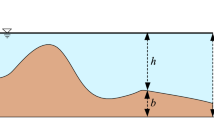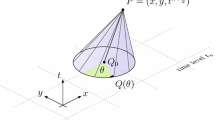Abstract
The stability of the high-order finite volume method for hyperbolic systems is based on non-linear procedures that prevent the creation of non-physical oscillations. Traditional techniques use the a priori paradigm where the procedure is carried out with the current time step solution. The a posteriori paradigm lies on an advanced in time candidate solution and a posterior evaluation of its stability, followed by a cure when necessary. To compare the two strategies, we propose a detailed study using the non-conservative shallow-water equations as a prototype, where both techniques are applied together in the framework of second-order linear reconstruction for the sake of simplicity. Then, a hybrid version combining the most positive aspects of both methods is proposed and analysed.



















Similar content being viewed by others
Data availability
All data generated or analysed during this study are included in this published article.
References
Abgrall, R.: On essentially non-oscillatory schemes on unstructured meshes: analysis and implementation. J. Comput. Phys. 114, 45–58 (1994)
Audusse, E., Bouchut, F., Bristeau, M.O., Klein, R., Perthame, B.: A fast and stable well-balanced scheme with hydrostatic reconstruction for shallow water flows. SIAM J. Sci. Comput. 25, 2050–2065 (2004)
Berger, M., Aftosmis, M.J., Murman S.M.: Analysis of slope limiters on irregular grids. In: Proceedings of the 43rd AIAA Aerospace Science Meeting, 10–13 January 2005
Berthon, C., Desveaux, V.: An entropy preserving MOOD scheme for the Euler equations. Int. J. Finite Vol. 11, 1–39 (2014)
Blachère, F., Turpault, R.: An admissibility and asymptotic preserving scheme for systems of conservation laws with source term on 2D unstructured meshes with high-order MOOD reconstruction. Comput. Method Appl. Mech. 317, 836–867 (2017)
Boscheri, W., Dumbser, M.: Arbitrary-lagrangian-eulerian discontinuous galerkin schemes with a posteriori subcell finite volume limiting on moving unstructured meshes. J. Comput. Phys. 479, 449–479 (2017)
Boscheri, W., Dumbser, M., Loubère, R., Maire, P.H.: A second-order cell-centered Lagrangian ADER-MOOD finite volume scheme on multidimensional unstructured meshes for hydrodynamics. J. Comput. Phys. 358, 103–129 (2018)
Boscheri, W., Loubère, R., Dumbser, D.: Direct arbitrary-Lagrangian–Eulerian ADER-MOOD finite volume schemes for multidimensional hyperbolic conservation laws. J. Comput. Phys. 292, 56–87 (2015)
Braeunig, J.-P., Loubère, R., Motte, R., Peybernes, M., Poncet, R.: A posteriori limiting for 2D Lagrange plus Remap schemes solving the hydrodynamics system of equations. Comput. Fluids 169, 249–262 (2018)
Carrier, G.F., Wu, T.T., Yeh, H.: Tsunami run-up and draw-down on a plane beach. J. Fluid Mech. 475, 79–99 (2003)
Clain, S., Reis, C., Costa, R., Figueiredo, J., Baptista, M.A., Miranda, J.M.: Second-order finite volume with hydrostatic reconstruction for tsunami simulation. J. Adv. Model. Earth Syst. 8(4), 1691–1713 (2016)
Clain, S., Diot, S., Loubère, R.: A high-order finite volume method for hyperbolic systems: multi-dimensional optimal order detection (MOOD). J. Comput. Phys. 230(10), 4028–4050 (2011)
Clain, S., Figueiredo, J.: The MOOD method for the non-conservative shallow-water system. Comput. Fluids 145, 99–128 (2017)
Clain, S., Loubère, R., Machado, G.J.: A posteriori stabilized sixth-order finite volume scheme for one-dimensional steady-state hyperbolic equations. Adv. Comput. Math. 44, 571–607 (2018)
Delestre, O., Lucas, C., Ksinant, P.-A., Darboux, F., Laguerre, C., Vo, T.-N.-T., James, F., Cordier, S.: SWASHES: a compilation of shallow water analytic solutions for hydraulic and environmental studies. Int. J. Numer. Methods Fluids 72, 269–300 (2013)
Deligant, M., Nogueira, X., Khelladi, S., Sauret, E., Reding, B.: Toward a high resolution real gas finite volume solver with multi optimal order detection. In: 5th International Seminar on ORC Power Systems, September 9–11, Athens, Greece (2019)
Deng, X., Xie, B., Loubère, R., Shimizu, Y., Xiao, F.: Limiter-free discontinuity-capturing scheme for compressible gas dynamics with reactive fronts. Comput. Fluids 171, 1–14 (2018)
Diot, S., Clain, S., Loubère, R.: Improved detection criteria for the multi-dimensional optimal order detection (MOOD) on unstructured meshes with very high-order polynomials. Comput. Fluids 64, 43–63 (2012)
Diot, S., Loubère, R., Clain, S.: The MOOD method in the three-dimensional case: very-high-order finite volume method for hyperbolic systems. Int. J. Numer. Methods Fluids 73, 362–392 (2013)
Dumbser, M., Loubère, R.: A simple robust and accurate a posteriori sub-cell finite volume limiter for the discontinuous Galerkin method on unstructured meshes. J. Comput. Phys. 199, 319–163 (2016)
Dumbser, M., Zanotti, O., Loubère, R., Diot, S.: A posteriori subcell limiting of the discontinuous Galerkin finite element method for hyperbolic conservation laws. J. Comput. Phys. 278, 47–75 (2014)
Farmakis, P.S., Tsoutsanis, P., Nogueira, X.: WENO schemes on unstructured meshes using a relaxed a posteriori MOOD limiting approach. Comput. Methods Appl. Mech. Eng. 363, 112–921 (2020)
Fernández-Fidalgo, J., Nogueira, X., Ramírez, L., Colominas, I.: An a posteriori, efficient, high-spectral resolution hybrid finite-difference method for compressible flows. Comput. Methods Appl. Mech. Eng. 335, 91–127 (2018)
Figueiredo, J., Clain, S.: On the solution of the slope beach problem in the context of shallow-water code benchmarking: why non-linearization of the initial waveforms is essential. Adv. Water. Res. 15, 1037 (2020)
Gaburro, E., Boscheri, W., Chiocchetti, S., Klingenberg, C., Springel, V., Dumbser, M.: High order direct arbitrary-Lagrangian–Eulerian schemes on moving Voronoi meshes with topology changes. J. Comput. Phys. 407, 109–167 (2020)
Giri, P., Qiu, J.: A high-order Runge–Kutta discontinuous Galerkin method with a subcell limiter on adaptive unstructured grids for two-dimensional compressible inviscid flows. Int. J. Numer. Methods Fluids 91, 367–394 (2019)
Godunov, S.K.: A difference scheme for numerical solution of discontinuous solution of hydrodynamic equations. Mat. Sbornik 47, 271–306 (1959)
Harten, A., Engquist, B., Osher, S., Chakravarthy, S.: Uniformly high order essentially non-oscillatory schemes III. J. Comput. Phys. 71, 231–303 (1987)
Jiang, Z.H., Yan, C., Yu, J.: Efficient methods with higher order interpolation and MOOD strategy for compressible turbulence simulations. J. Comput. Phys. 371, 528–550 (2018)
Kitamura, K., Hashimoto, A.: Simple a posteriori slope limiter (Post Limiter) for high resolution and efficient flow computations. J. Comput. Phys. 341, 313–340 (2017)
Kolgan, V.P.: Application of the minimum-derivative principle in the construction of finite-difference schemes for numerical analysis of discontinuous solutions in gas dynamics (in Russian). Trans. Cent. Aerohydr. Inst. 3, 68–77 (1972)
Liu, X.-D., Osher, S., Chan, T.: Weighted essentially nonoscillatory schemes. J. Comput. Phys. 115, 200–212 (1994)
Loubère, R., Dumbser, M., Diot, S.: A new family of high order unstructured MOOD and ADER finite volume schemes for multidimensional systems of hyperbolic conservation laws. Commun. Comput. Phys. 16(3), 718–763 (2014)
Maurizio, T., Dumbser, M.: A pressure-based semi-implicit space-time discontinuous Galerkin method on staggered unstructured meshes for the solution of the compressible Navier–Stokes equations at all Mach numbers. J. Comput. Phys. 341, 341–376 (2017)
Michel-Dansac, V., Berthon, C., Clain, S., Foucher, F.: A well-balanced scheme for the shallow-water equations with topography. Comput. Math. Appl. 72, 568–593 (2016)
Michel-Dansac, V., Berthon, C., Clain, S., Foucher, F.: A well-balanced scheme for the shallow-water equations with topography or Manning friction. J. Comput. Phys. 335, 115–154 (2017)
Murillo, J., García-Navarro, P.: Augmented versions of the HLL and HLLC Riemann solvers including source terms in one and two dimensions for shallow water flow applications. J. Comput. Phys. 231, 6861–6906 (2012)
Nogueira, X., Ramírez, L., Clain, S., Loubère, R., Cueto-Felgueroso, L., Colominas, I.: High-accurate SPH method with multidimensional optimal order detection limiting. Comput. Methods Appl. Mech. Eng. 310, 134–155 (2016)
Reis, C., Figueiredo, J., Clain, S., Omira, R., Baptista, M.A., Miranda, J.M.: Comparison between MUSCL and MOOD techniques in a finite volume well-balanced code to solve SWE. The Tohoku-Oki, 2011 example. Geophys. J. Int. 216(2), 958–983 (2019)
Tann, S., Deng, X., Shimizu, Y., Loubère, R., Xiao, F.: Solution property preserving reconstruction for finite volume scheme: a boundary variation diminishing+ multidimensional optimal order detection framework. Int. J. Numer. Methods Fluids 92(6), 603–634 (2020)
Toro, E.F., Spruce, M., Spares, W.: Restoration of the contact surface in the HLL Riemann solver. Shock Wave 4, 25–34 (1994)
Turpault, R., Nguyen-Bui, T.: A high order MOOD method for compressible Navier–Stokes equations: application to hypersonic viscous flows. Prog. Comput. Fluid Dyn. Int. J. 19(6), 337–345 (2019)
van Leer, B.: Towards the ultimate conservative difference scheme, V. A second order sequel to Godunov’s method. J. Comput. Phys. 32, 101–136 (1979)
von Neumann, J., Richtmyer, R.D.: A method for the numerical calculation of hydrodynamic shocks. J. Appl. Phys. 21, 232–237 (1950)
Vilar, F.: A posteriori correction of high-order discontinuous Galerkin scheme through subcell finite volume formulation and flux reconstruction. J. Comput. Phys. 387, 245–279 (2019)
Zanotti, O., Fambri, F., Dumbser, M., Hidalgo, A.: Space-time adaptive ADER discontinuous Galerkin finite element schemes with a posteriori sub-cell finite volume limiting. Comput. Fluids 118, 204–224 (2015)
Acknowledgements
The authors acknowledge the financial support by FEDER – Fundo Europeu de Desenvolvimento Regional, through COMPETE 2020 – Programa Operacional Fatores de Competitividade, and the National Funds through FCT – Fundação para a Ciência e a Tecnologia, Project No. POCI-01-0145-FEDER-028118, PTDC/MAT-APL/28118/2017. This work was partially financially supported by: Project POCI-01-0145-FEDER-028247 - funded by FEDER funds through COMPETE2020 - Programa Operacional Competitividade e Internacionalização (POCI) and by national funds (PIDDAC) through FCT/MCTES. This work was supported by the Portuguese Foundation for Science and Technology (FCT) in the framework of the Strategic Funding UIDB/04650/2020.
Author information
Authors and Affiliations
Corresponding author
Ethics declarations
Conflict of interest
The authors declare that they have no conflict of interest.
Additional information
Publisher's Note
Springer Nature remains neutral with regard to jurisdictional claims in published maps and institutional affiliations.
Rights and permissions
About this article
Cite this article
Figueiredo, J., Clain, S. A MOOD-MUSCL Hybrid Formulation for the Non-conservative Shallow-Water System. J Sci Comput 88, 2 (2021). https://doi.org/10.1007/s10915-021-01513-z
Received:
Revised:
Accepted:
Published:
DOI: https://doi.org/10.1007/s10915-021-01513-z




